
RBHI provides digital delivery of the FDA-recommended suicide-risk prediction and validated depression and anxiety scales.
Through the partnership with schools, RBHI can screen middle and high-school-aged students to identify youth and help them access care.
Why implement SLTC?
The Montana youth suicide rate has been steadily increasing for over a decade, indicating that current programming is not adequately addressing this devastating public health problem. A promising solution for suicide reduction is the use of digital screening for suicide risk coupled with mental health care in school settings. Screening reduces a significant barrier to suicide prevention: identifying at-risk youth. Once youth are identified, they can be helped.
Digital screening is an optimal suicide prevention tool as it is inexpensive, allows rapid screening of large numbers of students, and immediate reporting of at-risk youth to designated staff. Evidence consistently shows that adolescents (and adults) are more likely to divulge suicidal thoughts and behaviors in a digital survey than face-to-face with a clinician. Students who self-report having recent suicidality on the screener receive same-day care provided by school-based mental health providers or RBHI-contracted therapists.
How SLTC is implemented
Once a school expresses a desire to implement SLTC, the RBHI team shares information to find what will work best for each school. The RBHI team is available to answer questions, present to school stakeholders, and share information about digital screeners. Once schools are ready to screen, the RBHI team works closely with schools to schedule dates to implement screening for students. RBHI provides mental health professionals to see students needing same-day care, provides resources, and helps students access appropriate aftercare.
After screening
After screening students, schools receive a statistical analysis showing the proportions of students with positive and negative screens and other summary data. RBHI provides resources and educational guides for schools. Once RBHI has screened a school, our team is still involved in ensuring students can access care.

Classroom &
Educator Resources
While educators know what is best for their individual classrooms, here are some resources for incorporating mental health and positive emotional regulation in the classroom.


